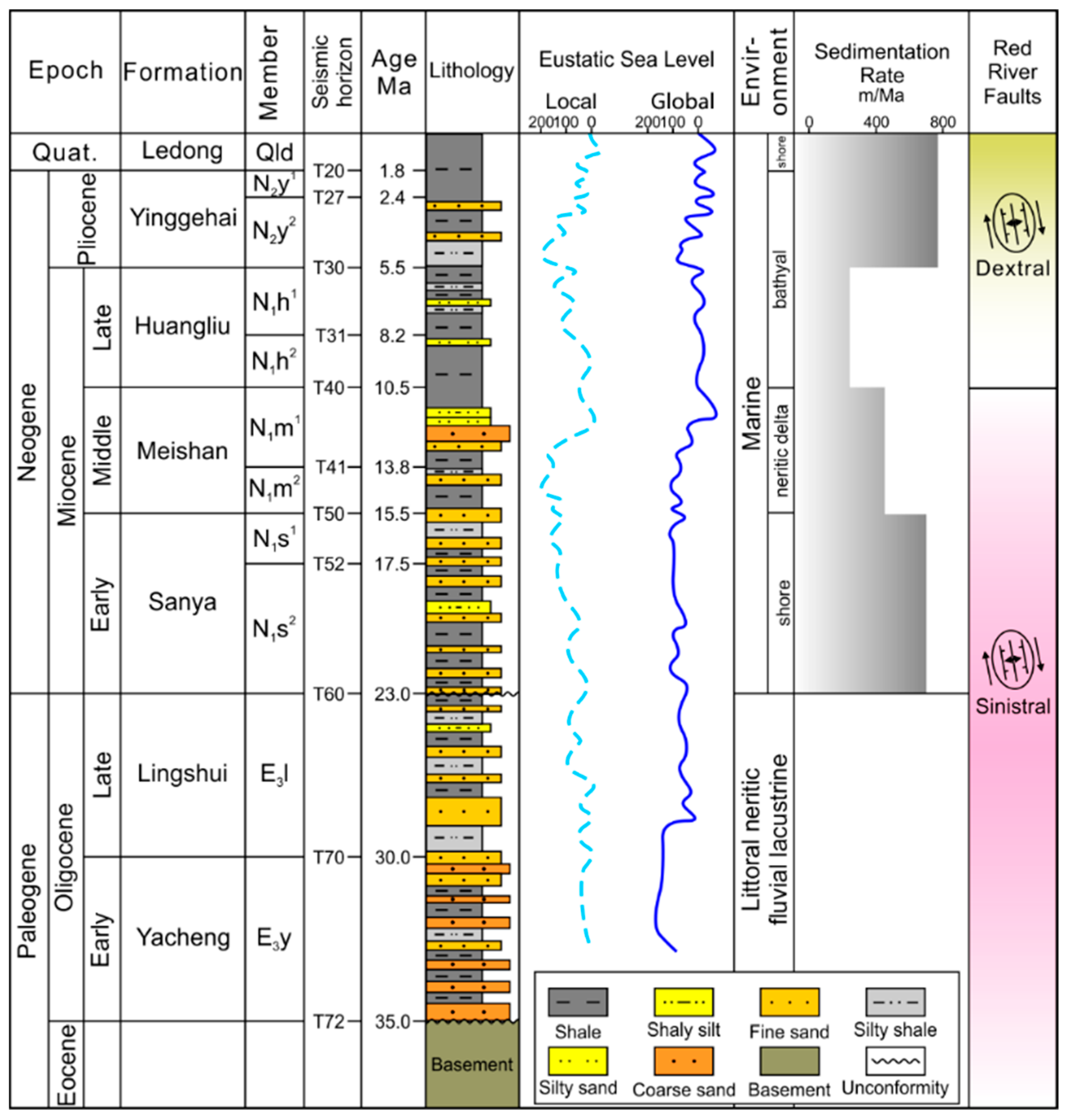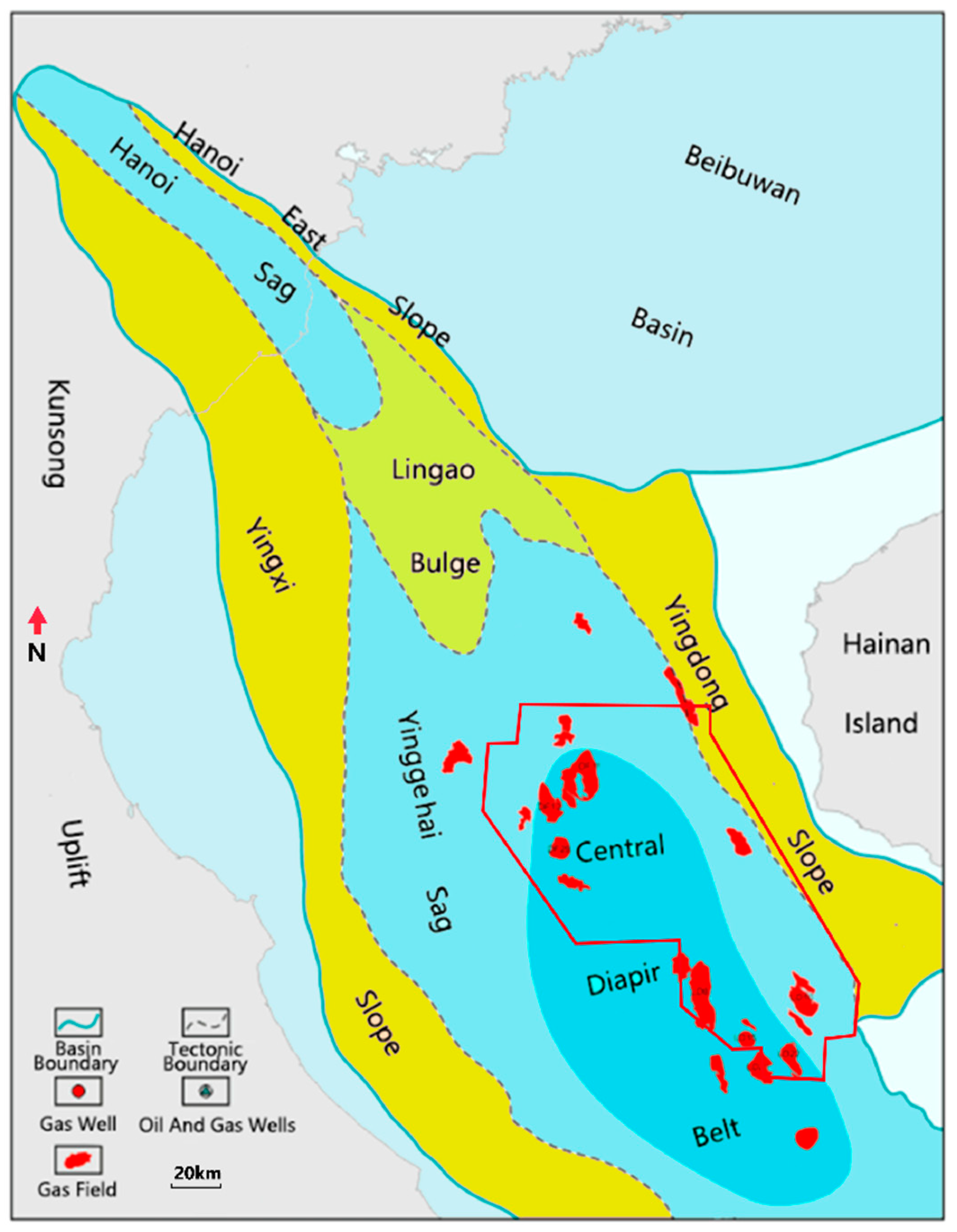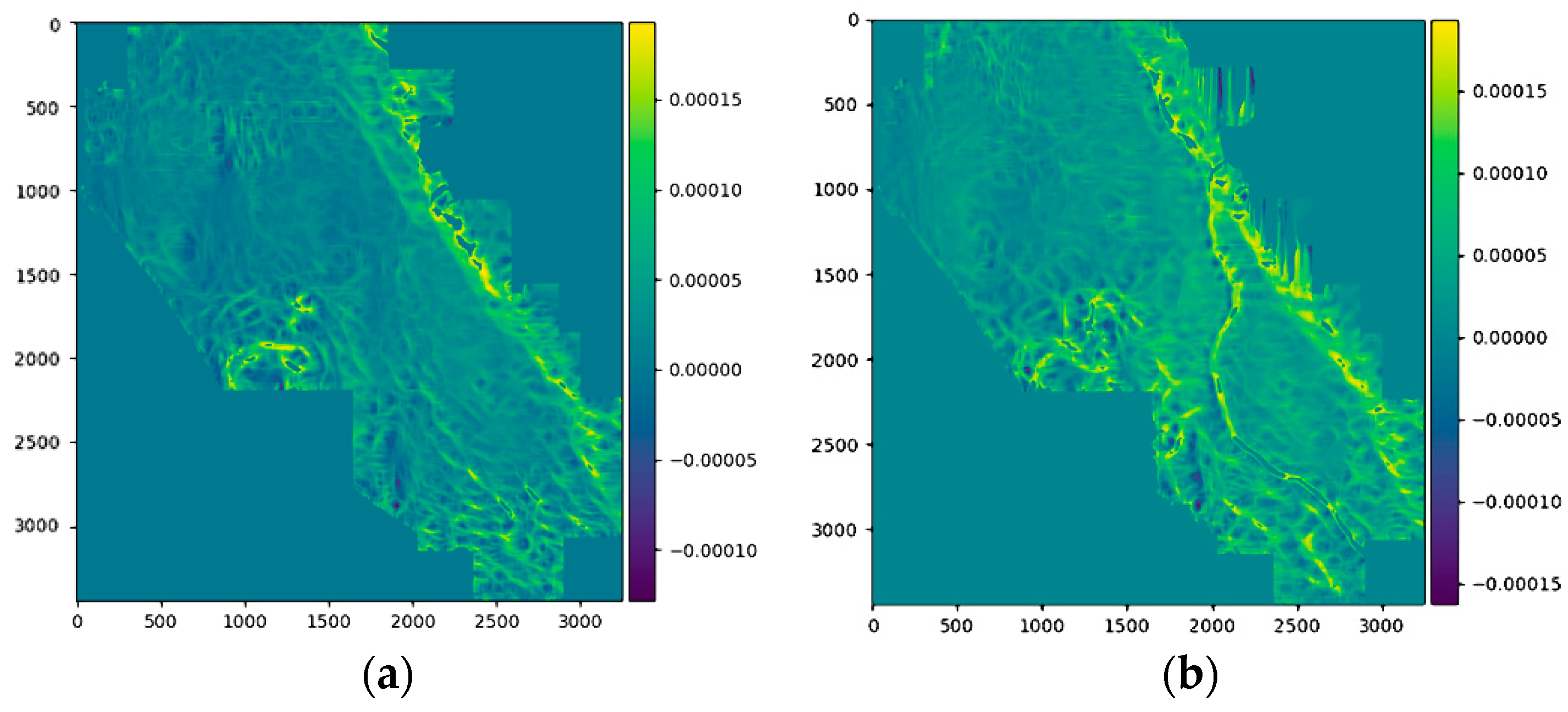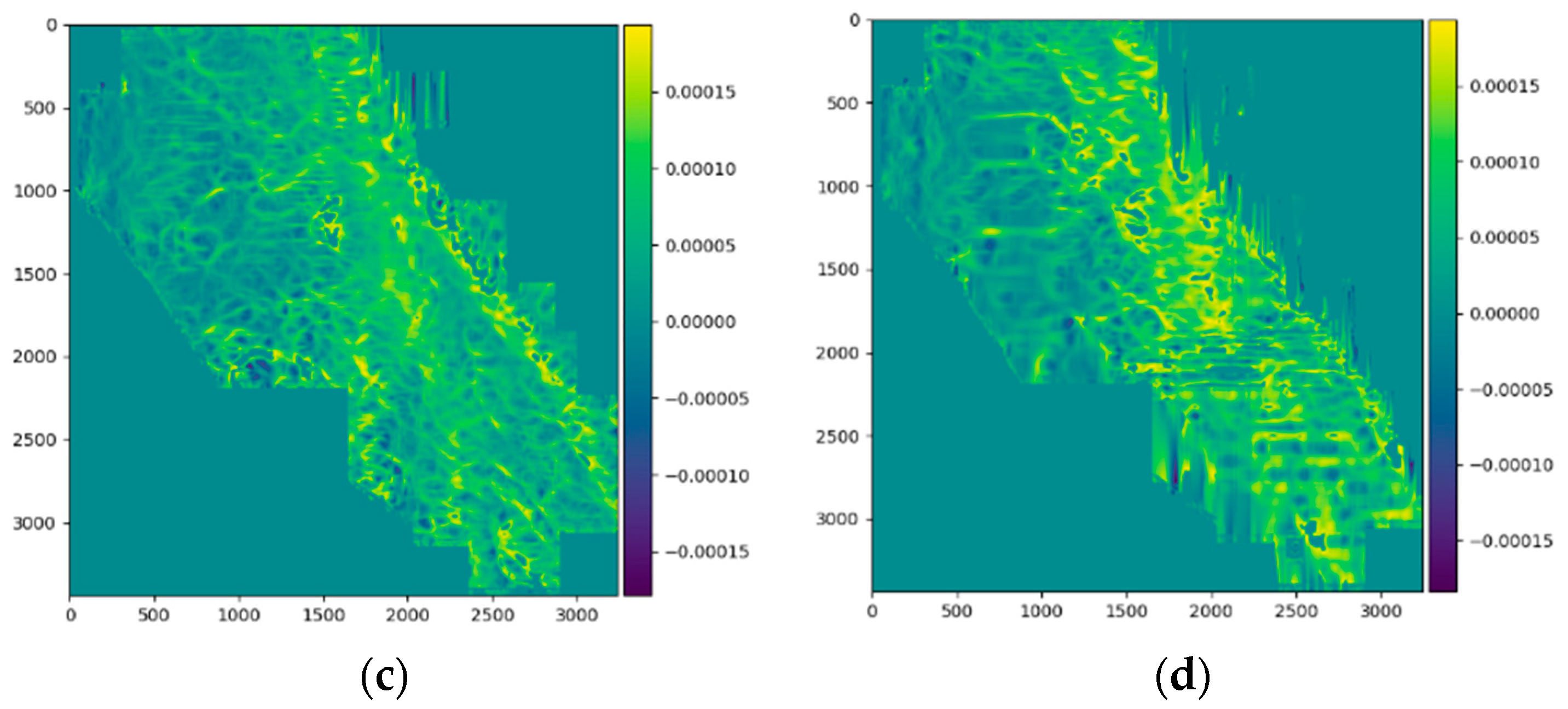A New Methodology Combining Geophysical Calculations and Geological Analysis to Identify and Characterize Carrier Systems for Vertical Hydrocarbon Migration in the Central Diapir Zone of the Yinggehai Basin, China
Abstract
:1. Introduction
2. Geological Background of Fracture Development

- (1)
- Faulted episode (Eocene to early Oligocene)
- (2)
- Faulted-depression episode (late Oligocene)
- (3)
- Thermal subsidence (Early to middle Miocene)
- (4)
- Accelerated deposition (Late Miocene to Quaternary)
3. The Seismic Attribute-Analysis Methodologies
3.1. Coherence Cube
3.2. Curvature
3.3. Results
- (1)
- Diapir-associated fractures
- Trans-tensional fractures
- Collapse fractures
- (2)
- Overpressure-associated fractures
- (3)
- Regional-stress associated fractures
4. The Carrier Systems and Hydrocarbon Accumulations
4.1. Diapirs
- Gas compositions vary at different tectonic locations
- Matching of diapir and gas accumulation
4.2. Regional Stress
5. Conclusions
Author Contributions
Funding
Data Availability Statement
Conflicts of Interest
References
- Luo, X. Simulation and characterization of pathway heterogeneity of secondary hydrocarbon migration. AAPG Bull. 2011, 95, 881–898. [Google Scholar] [CrossRef]
- Uliasz-Misiak, B.; Misiak, J.; Lewandowska-Smierzchalska, J.; Matula, R. Environmental Risk Related to the Exploration and Exploitation of Coalbed Methane. Energies 2020, 13, 6537. [Google Scholar] [CrossRef]
- Li, J.; Zhang, X.; Lu, B.; Ahmed, R.; Zhang, Q. Static Geological Modelling with Knowledge Driven Methodology. Energies 2019, 12, 3802. [Google Scholar] [CrossRef]
- Carruthers, D.J. Modeling of secondary petroleum migration using invasion percolation techniques. In Multidimensional Basin Modeling; AAPG/Datapages Discovery Series; Düppenbecker, S., Marzi, R., Eds.; AMER ASSOC PETROLEUM GEOLOGIST: Tulsa, OK, USA, 2003; No. 7; pp. 21–37. [Google Scholar]
- Yao, Y.; Guo, S. Source-to-sink characteristics of the channelized submarine fan system of the Huangliu formation in the Dongfang block, Yinggehai south China sea. J. Pet. Sci. Eng. 2021, 206, 109009. [Google Scholar] [CrossRef]
- Dimitrov, L. Mud volcanoes—The most important pathway for degassing deeply buried sediments. Earth Sci. Rev. 2002, 59, 49–76. [Google Scholar] [CrossRef]
- Sassen, R.; Milkov, A.; Roberts, H.; Sweet, S.; Defreitas, D.A. Geochemical evidence of rapid hydrocarbon venting from a seafloor-piercing mud diapir, Gulf of Mexico continental shelf. Mar. Geol. 2003, 198, 319–329. [Google Scholar] [CrossRef]
- Tong, C.; Xie, Y.; Huang, Z.; Ma, J. Geochemical behaviors of HPHT gas reservoirs in the Yinggehai Basin and the efficient gas accumulation mode in its diapir flanks. Nat. Gas Ind. 2015, 2, 144–154. [Google Scholar] [CrossRef]
- Huang, H.; Li, J.; Yang, H.; Zhang, G.; Gao, R.; An, J.; Luo, M.; Li, W. Influence of diapir structure on formation and distribution of overpressure in the Yinggehai Basin, South China Sea. Energy Sci. Eng. 2022, 10, 1972–1985. [Google Scholar] [CrossRef]
- Quintà, A.; Tavani, S.; Roca, E. Fracture pattern analysis as a tool for constraining the interaction between regional and diaper-related stress field: Poza de las Sal Diapir (Basque Pyrenees, Spain). Geol. Soc. Lond. Spec. Publ. 2012, 363, 521–532. [Google Scholar] [CrossRef]
- Sun, Y.; Wan, J.; Fu, X.; Yang, K.; Zhou, L.; Wang, J. Evolutionary of faults and their control on fractures in buried hill in Beier Depression. Pet. Explor. Dev. 2007, 34, 316–322. [Google Scholar]
- Ligtenberg, J.H. Detection of fluid migration pathways in seismic data: Implications for fault seal analysis. Basin Res. 2005, 17, 141–153. [Google Scholar] [CrossRef]
- Jenkins, C.; Quenes, A.; Zellou, A.; Ahmed, R.; Zhang, Q. Quantifying and predicting naturally fractured reservoir behavior with continuous fracture. AAPG Bull. 2009, 93, 1597–1608. [Google Scholar] [CrossRef]
- Han, X.; Deng, S.; Tang, L.; Cao, Z. Geometry, kinematics and displacement characteristics of strike-slip faults in the northern slope of Tazhong uplift in Tarim Basin: A study based on 3D seismic data. Mar. Pet. Geol. 2017, 88, 410–427. [Google Scholar] [CrossRef]
- Botter, C.; Marfurt, K.J.; Al-Dossary, S. Seismic characterisation of fault damage in 3D using mechanical and seismic modelling. Mar. Pet. Geol. 2016, 77, 973–990. [Google Scholar] [CrossRef]
- Li, M.; Zhao, Y. Chapter 4—Visualization and Spectral Decomposition. In Geophysical Exploration Technology; Li, M., Zhao, Y., Eds.; Elsevier: Oxford, UK, 2014; pp. 75–102. [Google Scholar]
- Bahorich, M.; Farmer, S. 3-D seismic discontinuity for faults and stratigraphic features: The coherence cube. Lead. Edge 1995, 14, 1053–1058. [Google Scholar] [CrossRef]
- Cohen, I.; Coult, N.; Vassiliou, A.A. Detection and extraction of fault surfaces in 3D seismic data. Geophysics 2006, 71, P21–P27. [Google Scholar] [CrossRef]
- Jeong, W.-K.; Whitaker, R.; Dobin, M. Interactive 3D Seismic Fault Detection on the Graphics Hardware; Graphics; The Eurographics Association: Zürich, Switzerland, 2006. [Google Scholar]
- Noori, M.; Hassani, H.; Javaherian, A.; Amindavar, H.; Torabi, S. Automatic fault detection in seismic data using Gaussian process regression. J. Appl. Geophys. 2019, 163, 117–131. [Google Scholar] [CrossRef]
- Song, W.; Liu, J. The calculation and application of coherence data body of seismic multi-vector attributes. Geophys. Geochem. Explor. 2003, 27, 128–130. (In Chinese) [Google Scholar]
- Wang, Y.; Zhao, Y.; Ding, W.; Ahmed, R.; Zhang, Q. Cenozoic Propagated Rifting in the Dangerous Grounds in Response to the Episodic Seafloor Spreading of the South China Sea. J. Earth Sci. 2022, 33, 1031–1046. [Google Scholar] [CrossRef]
- Sun, X.; Du, S. An application for power algorithm in the seismic attribute analysis. Comput. Tech. Geophys. Geochem. Explor. 2000, 22, 316–321. (In Chinese) [Google Scholar]
- Wang, X.; Yang, K.; Zhou, L.; Wang, J.; Liu, H.; Li, Y. Methods of calculating coherence cube on the basis of wavelet transform. Chin. J. Geophys. 2002, 45, 847–852. (In Chinese) [Google Scholar] [CrossRef]
- Jiang, P.; He, S.; Yang, Z.; Yang, K.; Wang, M.; Lan, Z.; Ren, S.; Zhang, R.; Zhao, X.; Yao, G. High CO2 Natural Gas Charging Events, Timing and Accumulation Pattern in LD10 Area of Yinggehai Basin. Earth Sci. 2022, 47, 1569–1585. [Google Scholar] [CrossRef]
- Zhu, J.; Wu, H.; Ma, J.; Liu, H.; Li, Y. Nature gas accumulation process and distribution differences in D1-1 diapir district, Yinggehai Basin. Geoscience 2015, 29, 54–62. (In Chinese) [Google Scholar]
- Cristescu, N.; Craciun, E.; Soós, E. Mechanics of Elastic Composites, 1st ed.; Chapman and Hall/CRC: Boca Raton, FL, USA, 2003. [Google Scholar] [CrossRef]
- Allen, C.R.; Pollard, D.D.; Ziony, J.I. Red River and associated faults, Yunnan Province, China: Quaternary geology, slip rates, and seismic hazard. GSA Bull. 1984, 95, 686–700. [Google Scholar] [CrossRef]
- Li, H.; Fan, C.; Jiang, Z.; Li, J.; Li, C.; Xu, X.; Li, F.; Hu, G. Natural Fractures in Low-Permeability Sandstone Reservoirs in the LD-A HPHT Gas Field, Yinggehai Basin: Implications for Hydrocarbon Exploration and Development. Front. Earth Sci. 2022, 10, 934097. [Google Scholar] [CrossRef]
- Ma, Z.; Yin, X.; Zong, Z. Fracture parameters estimation from azimuthal seismic data in orthorhombic medium. J. Nat. Gas Sci. Eng. 2022, 100, 104470. [Google Scholar] [CrossRef]
- Guo, Z.; Nie, N.; Liu, C. Fracture characterization based on improved seismic amplitude variation with azimuth inversion in tight gas sandstones, Ordos Basin, China. Mar. Pet. Geol. 2022, 146, 105941. [Google Scholar] [CrossRef]
- Durrani, M.Z.A.; Rahman, S.A.; Talib, M.; Subhani, G.; Sarosh, B. Characterization of seismic anisotropy using azimuthal AVO analysis (AVAz)—An application case study in the deep and tight carbonate reservoirs from Potwar Basin onshore Pakistan. J. Appl. Geophys. 2022, 205, 104767. [Google Scholar] [CrossRef]
- Marfurt, K.J.; Sudhaker, V.; Gersztenkorn, A.; Crawford, K.D.; Nissen, S.E.J.G. Coherency calculations in the presence of structural dip. Geophysics 1999, 64, 104–111. [Google Scholar] [CrossRef]
- Roberts, A. Curvature attributes and their application to 3D interpreted horizons. First Break. 2001, 19, 85–100. [Google Scholar] [CrossRef]
- Gersztenkorn, A.; Marfurt, K.J. Eigenstructure-based coherence computations as an aid to 3-D structural and stratigraphic mapping. Geophysics 1999, 64, 1468–1479. [Google Scholar] [CrossRef]
- Hakami, A.M.; Marfurt, K.J.; Al-Dossary, S. Curvature Attribute and Seismic Interpretation: Case Study from Fort Worth Basin; SEG Technical Program Expanded Abstracts; Society of Exploration Geophysicists: Houston, TX, USA, 2004; pp. 544–547. [Google Scholar]
- Al-Dossary, S.; Marfurt, K.J. 3D volumetric multispectral estimates of reflector curvature and rotation. Geophysics 2006, 71, P41–P51. [Google Scholar] [CrossRef]
- Chopra, S.; Marfurt, K.J. Multi-Spectral Volumetric Curvature Adding Value to 3D Seismic Data Interpretation; SEG Technical Program Expanded Abstracts; Society of Exploration Geophysicists: Houston, TX, USA, 2008; pp. 1585–1589. [Google Scholar]
- Jackson, M.P.A.; Roberts, D.G.; Snelson, S. Salt Tectonics: A Global Perspective; American Association of Petroleum Geologists: Tulsa, OK, USA, 1995. [Google Scholar]
- Rensbergen, P.V.; Morley, C.K.; Ang, D.W.; Hoan, T.Q.; Lam, N.T. Structural evolution of shale diapirs from reactive rise to mud volcanism: 3D seismic data from the Baram delta, offshore Brunei Darussalam. J. Geol. Soc. 1999, 156, 633–650. [Google Scholar] [CrossRef]
- Delaney, P.T.; Pollard, D.D.; Ziony, J.I.; McKee, E.H. Field relations between dikes and joints: Emplacement processes and paleostress analysis. J. Geophys. Res. Atmos. 1986, 91, 4920–4938. [Google Scholar] [CrossRef]
- Fan, C.; Li, M.; Zhao, Y. Identification and Prediction of Allo-Source Overpressure Caused by Vertical Transfer: Example from an HTHP Gas Reservoir in the Ledong Slope in the Yinggehai Basin. Geofluids 2021, 2021, 6657539. [Google Scholar] [CrossRef]
- Li, C.; Sun, X.; Du, S. New understanding of overpressure responses and pore pressure prediction: Insights from the effect of clay mineral transformations on mudstone compaction. Eng. Geol. 2022, 297, 106493. [Google Scholar] [CrossRef]








| Curvatures | Equations |
|---|---|
| Mean curvature | |
| Gaussian curvature | |
| Maximal curvature | |
| Minimal curvature | |
| Maximal positive curvature | |
| Minimal negative curvature |
| Areas | Depth | δ13 C1/‰ | δ13 C2/‰ | |||||
|---|---|---|---|---|---|---|---|---|
| −40 to −38 | −38 to −35 | −35 to −32 | −32 to −30 | −20 to −12 | −12 to −8 | −8 to 0 | ||
| Diapir area | Shallow layers | 0 | 0 | 1 | 4 | 0 | 0 | 5 |
| Mid-deep layers | 0 | 1 | 4 | 9 | 0 | 2 | 12 | |
| Diapir-affected area | Mid-deep layers | 3 | 7 | 4 | 1 | 9 | 6 | 2 |
Disclaimer/Publisher’s Note: The statements, opinions and data contained in all publications are solely those of the individual author(s) and contributor(s) and not of MDPI and/or the editor(s). MDPI and/or the editor(s) disclaim responsibility for any injury to people or property resulting from any ideas, methods, instructions or products referred to in the content. |
© 2023 by the authors. Licensee MDPI, Basel, Switzerland. This article is an open access article distributed under the terms and conditions of the Creative Commons Attribution (CC BY) license (https://creativecommons.org/licenses/by/4.0/).
Share and Cite
Fan, C.; Wu, K.; Li, J. A New Methodology Combining Geophysical Calculations and Geological Analysis to Identify and Characterize Carrier Systems for Vertical Hydrocarbon Migration in the Central Diapir Zone of the Yinggehai Basin, China. Energies 2023, 16, 1774. https://doi.org/10.3390/en16041774
Fan C, Wu K, Li J. A New Methodology Combining Geophysical Calculations and Geological Analysis to Identify and Characterize Carrier Systems for Vertical Hydrocarbon Migration in the Central Diapir Zone of the Yinggehai Basin, China. Energies. 2023; 16(4):1774. https://doi.org/10.3390/en16041774
Chicago/Turabian StyleFan, Caiwei, Kongyou Wu, and Jun Li. 2023. "A New Methodology Combining Geophysical Calculations and Geological Analysis to Identify and Characterize Carrier Systems for Vertical Hydrocarbon Migration in the Central Diapir Zone of the Yinggehai Basin, China" Energies 16, no. 4: 1774. https://doi.org/10.3390/en16041774
APA StyleFan, C., Wu, K., & Li, J. (2023). A New Methodology Combining Geophysical Calculations and Geological Analysis to Identify and Characterize Carrier Systems for Vertical Hydrocarbon Migration in the Central Diapir Zone of the Yinggehai Basin, China. Energies, 16(4), 1774. https://doi.org/10.3390/en16041774






